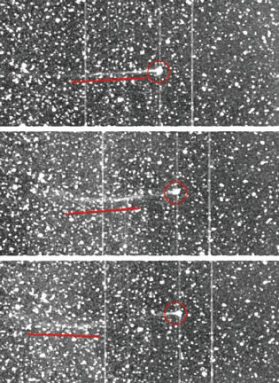Sun Got Your Tail?
Solar storms can tear the tail right off a comet.
An amateur astronomer made a surprising discovery last spring. He discovered that a comet orbiting the sun appeared to have lost one of its two tails. Scientists are now studying this comet and others in greater detail.
Comets are balls of ice, rock, and dust that make long, noncircular orbits around the sun. When a comet gets near the sun, part of it melts, creating what looks like a tail.
In fact, two tails normally stream behind a comet’s main body. One tail, made of dust, shines brilliantly as it reflects sunlight. The other tail, called an ion tail, is much dimmer. It forms when something called the solar wind blows past a comet.
 |
|
This sequence of images, from top to bottom, shows the tail of Comet 2P/Encke being chopped off. One of a pair of spacecraft called STEREO took the images. |
| NASA |
The solar wind is a stream of charged particles that comes off the sun. This wind sweeps gas molecules from the inside of the comet into a tail of charged particles that stretches for millions of kilometers into space.
Charged particles such as these are called ions. A trail of ionized particles is called an ion tail.
Last spring, an amateur astronomer was looking at a movie made out of images taken by one of a pair of spacecraft called STEREO. These spacecraft orbit the sun. In the movie, which was posted online, the amateur noticed that the ion tail of a comet called 2P/Encke got crunched, and then ripped off.
He notified Angelos Vourlidas, a researcher at the Naval Research Laboratory in Washington, D.C., about his observation.
“Everyone was speechless,” when they saw the images, Vourlidas recalls. The images provide the first clear evidence of a comet losing one of its tails.
Vourlidas and colleagues watched the movie that the amateur astronomer had brought to their attention. They noticed that just as the comet lost its tail on April 20, a cloud of charged particles from the sun, called a coronal mass ejection (CME), swept past the object. A few hours later, the comet grew its ion tail back, using particles from the comet’s core.
But that wasn’t all. A review of earlier data showed that Comet 2P/Encke had also lost its ion tail on April 19, just a day before the reported sighting. During that event, a second bright blob appeared in the same images. The blob may have been another CME from the same region of the sun that caused the April 20 event, the researchers suspect.
The new images provide some of the most convincing evidence to date that storms on the sun’s surface can chop off parts of the comets looping past them. The findings suggest that interactions between CMEs and comets “are more common than we thought,” Vourlidas says.—Jennifer Cutraro
Going Deeper:
Cowen, Ron. 2007. Sunstruck: Solar hurricanes rip comet’s tail. Science News 172(Oct. 13):228. Available at http://www.sciencenews.org/articles/20071013/fob3.asp .
For a movie and images of the ripped tail of Comet 2P/Encke, go to science.nasa.gov/headlines/y2007/01oct_encke.htm (Science@NASA).
For information on the STEREO spacecraft, go to www.nasa.gov/stereo/ (NASA).







